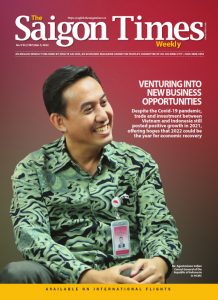The post-pandemic economy is a topic of great interest in the first days of the year, for the entire country as well as HCMC, the latter being the most important hub of the country. The issue is of paramount importance, not only because the city’s economy has been adversely affected by the pandemic, but also because of the need for the city to reposition its driving force for growth in the coming years.
A decelerating locomotive
HCMC has been the focal economic zone of the country over the past three decades since the country’s open-door policy, accounting for 21% of the country’s GDP in the 2011-2020 period. The city’s average income per capita was also twice as much as the country’s level of VND6 million a month as of the end of 2020.
However, if the growth rate is broken down, it can be seen that in each period of upheavals of the national economy, the average economic growth of the city has taken a downtrend. The role of HCMC as well as Hanoi as the economic locomotive is still irreplaceable, but its importance has been watered down owing to the emergence of other localities like Binh Duong and Dong Nai. Given the vast low-cost land fund, these localities have been attracting many processing and manufacturing enterprises over the past years.
On the other hand, actions taken by the city government to tighten legal requirements for real estate projects have also dwindled this sector’s contribution to the city’s growth. In the long run, this sector’s contribution will further narrow down as the city’s land fund is exhausted.
So what are the spearhead sectors that HCMC needs to focus resources on in the coming years?
A close look into major economic hubs in the world reveals the major role of financial services in economic growth, and no advanced economies are not associated with a developed financial service sector. Specifically, the financial service sector holds a share of 20% or more of the economy of New York, London, Bangkok or Kuala Lumpur owing to the advantages of infrastructure and human resources in such megacities. HCMC should not be an exception.
In the gross regional domestic product of HCMC in 2021, nine key service subsectors made up nearly 60% of the city’s total revenue, with the financial, banking and insurance services as a whole rising over 11% to VND132 trillion, while other sectors tumbled or ground to a halt. This sector accounted for 10.2% of the city’s GDP in 2021 compared to 8.7% in 2020, which asserts the increasing importance of the financial service sector in the national economy in general and HCMC in particular.
As HCMC is facing numerous difficulties to develop infrastructure due to a low budget allocation, the city is in dire need of financial breakthroughs to make use of its advantages compared to other localities, and to make the most of macroeconomic changes post-pandemic.
A financial solution for both HCMC and the Mekong Delta region
Vietnam remains an agriculture-based economy with many export commodities among the world’s biggest like rice, coffee, pepper and cashew. HCMC is the export convergent point for farm produce from other neighboring localities thanks to the country’s biggest deep-water seaports being located there.
Therefore, if this advantage can be tapped — coupled with the city’s position as the country’s biggest financial center — to develop a particular financial product that helps address issues of the agricultural sector and leverages the city’s economy, then the benefit will be sizeable. No financial service can meet the moment better than establishing a futures market for commodities.
The Trung Luong-My Thuan Expressway being opened to traffic late last year is the welcome news for the country, as it helps ease a long-lasting pressure in the economy, which is the higher logistics cost as a proportion of the GDP compared to other countries. Further, the expressway also accelerates the flow of agricultural commodities from the country’s biggest rice bowl to the country’s biggest financial center. Despite hiccups in the construction of the expressway, the completion of this road ushers in opportunities for the Mekong Delta region in the coming time.
Importance of a commodity market
The story of a commodity market surfaced in Vietnam ten years ago following the establishment of a coffee exchange in Daklak, but the poor market liquidity coupled with unsuitable market conditions rendered the project a failure. Years later, the concept was revived, with the Ministry of Industry and Trade letting fly the project to establish the commodity exchange in 2018. The Vietnam Commodity Exchange will connect commodity transactions of local and foreign exporters with international commodity exchanges. Vietnamese rice exporters can have futures transactions at pre-determined prices, hedging themselves against risks of price volatility often seen on the market for spot transactions.

A commodity exchange’s functions are not limited to hedging against price volatility, as it also undertakes physical deliveries of commodities. Instead of settling contracts before the due date, eligible traders can engage in commodity forwarding contracts in due time. Given Vietnam’s huge export volume, the establishment of a commodity exchange, especially the physical delivery, will not only promote trade, boost prices of Vietnamese farm produce, and prevent risks for farmers and enterprises, but also help increase tax revenues for HCMC in the coming time.
In terms of the human resource in the financial service sector, other neighboring localities are not comparable to HCMC. Most of banks and major financial institutions in the South are headquartered in HCMC. Moreover, major deep-water seaports in the Cai Mep Complex in Ba Ria-Vung Tau Province are also favorable conditions for Vietnam to cater to huge vessels shipping export commodities.
All southern economic areas have their own advantages and potentials for development, and therefore, turning HCMC into a financial center to make the most of the development potentials of other neighboring localities will be a suitable strategy to develop the city’s economy in the long run.
(*) CFA
(**) Saigon Futures









